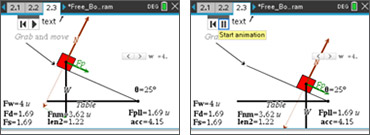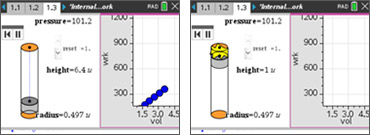Best of Physics Activities for the Fall Semester
The ScienceNspired.com website is an excellent resource for any science teacher looking for lessons and content that can be used either in person or online. The colorful and engaging simulations help bring the concepts to life for students by enabling them to test variables and challenge their own ideas. Take a look at some of the best physics activities below. These are just a few of the many activities available for free with your TI-Nspire™ CX Premium Teacher Software or TI-Nspire™ CX or TI-Nspire™ CX II graphing calculator. Don’t have the software? Click here to get started.
1. Skills of Science: Tool — Vector
When your students get to vectors, have them use this TI-Nspire™ tool. It allows students to explore the mathematics of vectors such as magnitude, direction, addition, subtraction and multiplication of vectors.

2. Forces and Motion: Newton’s Second Law
Although this lesson has been around for a long time, it does a really nice job in helping students see and understand Newton’s second law through the use of a simple simulation meant to collect data on mass, force and acceleration.

3. Forces and Motion: Free Body Diagrams
This activity has several simulations that let students interact with forces due to weight and normal force on an incline plane. Later in the lesson, students will also adjust for frictional forces.

4. Work, Energy and Momentum: Work and Power — Physics: Energy Skate Park (HS)
This lesson enables students to observe differences in the motion of a skateboarder in three different gravitational environments. Students will also observe the relationships between kinetic, potential and total energy. This activity was adapted from the popular Phet series of simulations.

5. Rotational Equilibrium and Simple Machines: Simple Machines — Balancing Act (HS)
Adapted from the popular Phet simulations, Balancing Act is broken into two parts: Lab and Game. In the Lab section, students experiment with rotational equilibrium by balancing objects of different mass at different distances relative to the fulcrum. In the Game section, students are given a series of challenges with an object of unknown mass at a known distance and must balance the teeter-totter.

6. Heat and Thermodynamics: First of Law of Thermodynamics — Internal Energy and Work
In this lesson, students will develop the equation for work by observing the relationship between volume change and work done in a cylinder and piston at constant pressure. Students will interact with a simulation and collect data to develop the equation.

About the author: Erick Archer is a Market Strategy Manager at Texas Instruments and works with science and STEM teachers in the implementation of TI technology. He is also a former high school science teacher, father of two sons, married to his high school sweetheart and LOVES baseball.
Tags:
- force
- motion
- energy
- kinetic
- potential
- friction
- vector
- resultant vector
- component vector
- vector addition
- vector multiplication
- work
- power
- Newton’s Laws
- free body diagram
- normal force
- rotational motion
- rotational equilibrium
- torque
- simple machine
- fulcrum
- lever
- heat
- thermodynamics
- laws of thermodynamics
Tagcloud
Archive
- 2025
- 2024
-
2023
- January (3)
- February (3)
- March (5)
- April (3)
- May (3)
- June (3)
- July (2)
-
August (6)
- 5 Ways to Spruce Up Your Classroom for Back to School
- Day of the Dog: Which Dog Is Roundest?
- Women Who Code: A TI Intern’s Fascinating STEM Journey
- 6 Sensational TI Resources to Jump-Start Your School Year
- 3 Back-to-School Math Activities to Reenergize Your Students
- A New School Year — A New You(Tube)!
- September (2)
- October (3)
- November (1)
- 2022
-
2021
- January (2)
- February (3)
- March (5)
-
April (7)
- Top Tips for Tackling the SAT® with the TI-84 Plus CE
- Monday Night Calculus With Steve Kokoska and Tom Dick
- Which TI Calculator for the SAT® and Why?
- Top Tips From a Math Teacher for Taking the Online AP® Exam
- Celebrate National Robotics Week With Supervised Teardowns
- How To Use the TI-84 Plus Family of Graphing Calculators To Succeed on the ACT®
- AP® Statistics: 6 Math Functions You Must Know for the TI-84 Plus
- May (1)
- June (3)
- July (2)
- August (5)
- September (2)
-
October (4)
- Transformation Graphing — the Families of Functions Modular Video Series to the Rescue!
- Top 3 Halloween-Themed Classroom Activities
- In Honor of National Chemistry Week, 5 “Organic” Ways to Incorporate TI Technology Into Chemistry Class
- 5 Spook-tacular Ways to Bring the Halloween “Spirits” Into Your Classroom
- November (4)
- December (1)
-
2020
- January (2)
- February (1)
- March (3)
- April (1)
- May (2)
- July (1)
- August (2)
- September (3)
-
October (7)
- Tips for Teachers in the time of COVID-19
- Top 10 Features of TI-84 Plus for Taking the ACT®
- TI Codes Contest Winners Revealed
- Best of Chemistry Activities for the Fall Semester
- Best of Biology Activities for the Fall Semester
- Best of Physics Activities for the Fall Semester
- Best of Middle Grades Science Activities
- November (1)
- December (2)
- 2019
-
2018
- January (1)
- February (5)
- March (4)
- April (5)
- May (4)
- June (4)
- July (4)
- August (4)
- September (5)
-
October (9)
- Art in Chemistry
- Which Texas Instruments (TI) Calculator for the ACT® and Why?
- Meet TI Teacher of the Month: Jessica Kohout
- Innovation in Biology
- Learning With Your Students
- A first-of-its-kind STEM strategy charts path to help educators
- #NCTMregionals Hartford 2018 Recap
- The Math Behind “Going Viral”
- Real-World Applications of Chemistry
-
November (8)
- Testing Tips: Using Calculators on Class Assessments
- Girls in STEM: A Personal Perspective
- 5 Teachers You Should Be Following on Instagram Right Now
- Meet TI Teacher of the Month: Katie England
- End-of-Marking Period Feedback Is a Two-Way Street
- #NCTMregionals Kansas City 2018 Recap
- Slope: It Shouldn’t Just Be a Formula
- Hit a high note exploring the math behind music
- December (5)
- 2017
- 2016
- 2015
